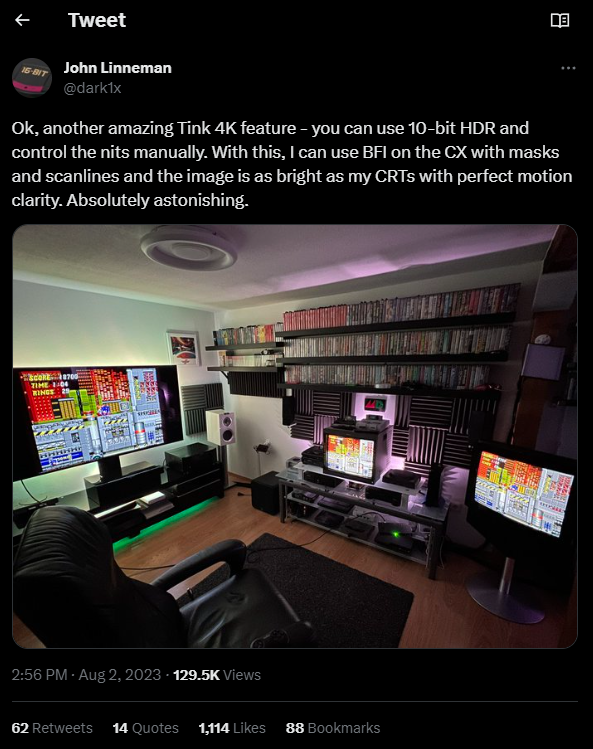jorimt wrote: ↑05 Aug 2023, 11:41
NeonPizza wrote: ↑05 Aug 2023, 06:55
Zero motion blur
120-144fps
Do note, that's not 100% achievable at that frame/refresh rate due to
stroboscopic effect. And if displays ever do achieve retina frame/refresh rates, faster motion just ends up blurring again anyway.
Motion clarity nuts need to remember real eyes experience motion blur too, we just don't want any added on top of it by the display, same goes for latency; the ultimate goal with any external peripheral is for the human body to become the only bottleneck, which "ain't even close to perfect" either.
WHOA!
Watch that dangerous semantics rabbit hole, jorim



My experience is that I went into giant arguments about terminology because we were talking about apples vs oranges, so -- this PSA applies to moderators here -- to correct everybody's use of terminology, but I want to be careful that people on Blur Busters Forums distinguish the different types of blurs.
Not everyone talks about the same blurs. When most people say "zero blur", they want the CRT effect. This is much closer (albiet not quite) achievable with 60Hz via external BFI boxes on 240Hz OLEDs (such as Retrotink 4K, which can do HDR nit-boosting for BFI brighter than LG OLED BFI) -- I am working with Mike of Retrotink to add BFI via an external video processor box, for BFI enthusiasts.
Here's a list of the 3 most common kinds of "blurs" that many people talk about, some fixable, and some unfixable:
- Stroboscopic Effect
- Persistence Blur (Frametime blur / Sample and hold blur / Pulsewidth blur)
- GtG Ghosting
To readers: Nuance the type of blur you're picky about.
To moderators: Acknowledge that when people say zero blur, remind the 3 main kinds of blurs. The said person may be referring to item #2 (CRT tubes)
I've been enough arguments to find out how I can make the person quickly agree with me, once I gave them a menu that made them realize exactly what they wanted / what they were picky about.
Now, there's also a human perceptual biasing effect. Flicker-free 4ms MPRT on OLED often looks (roughly) as low blur as Flickery 2.4ms MPRT of old NVIDIA LightBoost. Although not quite zero blur for ultra fast motion speeds, games like Super Mario are slowly scrolling enough (even at maximum scroll speeds) that they go sufficiently darn near blurless at 4ms MPRT. So, many find that sufficiently good enough, if they're targetting temporal CRT simulation for CRT resolution content.
Higher resolutions amplify display motion blur visibility, so the type of material you play, and their relative scroll speeds, can determine your MPRT requirements. The low resolution retro stuff tend to work pretty well at 2-4ms MPRT, while modern stuff you may be picky enough to go 0.5ms-1ms MPRT (not yet achievable on direct-view OLED).
For ultrafast high-resolution motion, LCD strobing massively outperforms OLED BFI by an order of magnitude. However, for retro purposes, getting to roughly plasma-quality motion (which 240Hz OLEDs can achieve with an external box like the upcoming Retrotink 4K I'm working with), is usually good enough for most.
The low resolutions, means even 4 pixels/frame scrolling is a fairly fast horizontal scroll at things like 224-pixel-wide retro video game consoles, and quarter-persistence (4ms MPRT 60Hz) looks zero-blur at this scroll speed.
Also, check out
External BFI Injector Box -- Retrotink 4K Video Processor/Scaler which can add either CRT scanline effects -- or BFI -- or both simultaneously!
External BFI Injector Solution
The amazing thing is that Retrotink 4K does brighter BFI on LG OLEDs than the LG OLED's built in BFI!

- retrotink4k.png (55.68 KiB) Viewed 12892 times
It's a box-in-middle that goes between your source (console/retro/xbox/playstation/computer/FireTV/etc) and the display, and even supports 240Hz via ModeLines on SD cards. Whether you want to do 96Hz doublestrobe (35mm projector simulator) or add 120/180/240Hz BFI to your Nintendo, you can do it now with the upcoming Retrotink 4K box. And yes, you can connect a PC/Mac of any OS through its HDMI input -- although at lower resolutions and lower refresh rates (720p-1080p), depending on output resolution you plan to use. It's retro marketed, but the ability to partially simulate a CRT temporally and spatially is something that an external box can do (add scanlines filter + add BFI!).
That's because it converts retro SDR video input (e.g. Super Nintendo) to a HDR colorspace, then applies HDR brightness-boosting. We found that in certain cases, we can brighten 50%-cadence 60Hz BFI to become brighter than 60Hz non-BFI.
As I've been pissed at 240Hz OLEDs lack of BFI, I'm putting matters into my hands and helping someone throw BFI straight into a box-in-middle which can be used with almost any high-Hz sample and hold display. Problem solved, and I outperform the TV's BFI in brightness to boot!
DigitalFoundry Retro Nut Confirms
twitter.com/dark1x/status/1686843392917954560

- retrotink-4k-bfi-hdr-boost.png (455.21 KiB) Viewed 12903 times
Includes:
- Custom Hz support (Linux style ModeLines in a text file on a SD card you insert into Retrotink)
- Variable persistence BFI (if output Hz supports)
- Multistrobe BFI (for fans who want to simulate a 35mm projector)
- LCD saver (prevents image retention)

- retrotink-features.png (175.51 KiB) Viewed 12886 times
(Mike is the founder of Retrotink)

